
* In the wake of the Korean War, the USA began to introduce advanced supersonic combat aircraft to meet the perceived threat of the Red Menace. The first such to go into service was the North American "F-100 Super Sabre", more generally known as the "Hun", which gave excellent service in the Vietnam War. This document provides a history and description of the F-100, and its derivative, the "F-107". A list of illustration credits is provided at the end.
* The North American Aviation (NAA) F-100 Super Sabre began life in February 1949 as a redesign of the F-86 Sabre for supersonic performance, featuring a more powerful engine and a wing with a sweepback of 45 degrees, in contrast to the 35 degrees of the F-86. The project, internally named "Sabre 45", was company-funded, the design team being led by Ray Rice. An XF-86D was modified with the 45-degree wing, the tailplane also being moved to the base of the tail.
The Korean War broke out in the summer of 1950; NAA offered the Sabre 45 to the US Air Force (USAF) in August, to be told there was no immediate need for a new jet fighter. However, NAA was also told there might well be a need not too far down the road, and so the company ramped up development work on the design -- which was given the company code of "NA-180" -- from January 1951.
By that time, the Communists had introduced the MiG-15 fighter into combat over Korea; the F-86 was able to match the MiG-15, but what might happen if the Soviets introduced an improved jet fighter? In November, the Air Force authorized construction of two flight prototypes of the NA-180, with the company then showing off a full-scale mockup of the design to USAF brass, who were suitably impressed. In December, the NA-180 was assigned the service designation of "F-100"; in early 1952, the USAF gave formal approval for construction of the two "YF-100" prototypes, as well as an initial batch of production "F-100A" machines. The design concept had evolved so far from a "supersonic F-86" that the F-100 had no more than a general configurational resemblance to the Sabre.
The initial YF-100A prototype was built at North American's Inglewood plant in the Los Angeles, California, area. It was fitted with a Pratt & Whitney XJ57-P-7 turbojet, lacking the afterburner anticipated for production engines, with a maximum thrust of 37.8 kN (3,855 kgp / 8,500 lbf). The YF-100A made its initial flight on 25 May 1953 from Edwards Air Force Base, with North American test pilot George "Wheaties" Welch at the controls. Welch had also performed initial flights for many variants of the North American F-86 Sabre; in addition, he had an illustrious combat career during World War II, even claiming a number of "kills" in a Curtiss P-40 during the Pearl Harbor attack on 7 December 1941.
Although the YF-100A didn't have an afterburning engine, it still broke Mach 1 in level flight on its first flight; it would be the first US aircraft for full operational service to do so. The second YF-100 flew on 14 October 1953, this machine being used for armament tests, while the first YF-100 remained focused on flight trials. Evaluation demonstrated that the YF-100A was in a new league of performance for the Air Force, but also that the aircraft had several deficiencies that needed correction: visibility over the nose for landings was bad, the aircraft landed too "hot", and its low-speed handling was dodgy. Its climb rate was poor -- but that problem was seen as likely to be corrected in production machines with the afterburning engine.
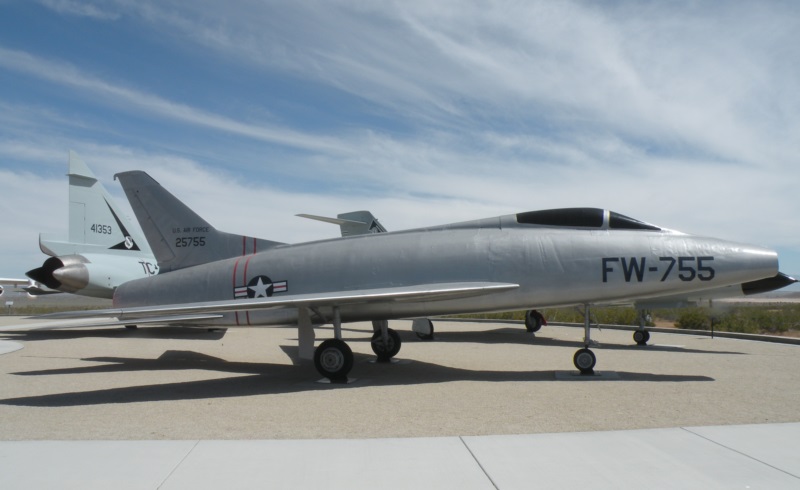
The first production F-100A, with an afterburning engine, was handed over to the Air Force for evaluation on 26 October 1953, with Colonel Frank K. "Pete" Everest then breaking a world speed record with it on 29 October, flying a 15 kilometer (9.3 mile) circuit over the Salton Sea, California, at a speed of 1,215.261 KPH (755.149 MPH). The first operational unit to receive the F-100A was the 479th Fighter Day Fighter Wing at George AFB in California, the aircraft arriving in October 1954, with the "Super Sabre", as it was named, declared operational in September. The second YF-100A survives today, on display at Edwards AFB.
BACK_TO_TOP* The F-100A provides a baseline for the Super Sabre family. It was made mostly of aircraft aluminum alloys, though it did incorporate some titanium components; it was one of the first US service aircraft to do so. It had all-swept flight surfaces and tricycle landing gear. The wing and tailplane were low-mounted; the tailfin featured a forward fin fillet; and the tailplane was "all-moving", without elevators, positioned below the wing in hopes of addressing "pitch-up" problems that had afflicted other high-speed jet designs.
The wings had ailerons, automatic leading-edge slats, but no flaps. There was a large, single-piece dive brake under the belly. The powerplant was a P&W J57-P-7 afterburning turbojet, with 66.8 kN (6,805 kgp / 15,000 lbf) afterburning thrust, fed by an oval intake in the nose. There was a long pitot tube under the intake, with the tube being hinged up to protect it on the flight line. There were five fuel tanks, all in the fuselage. The two-wheel nose gear retracted backward, while the single-wheel main gear hinged in the wing to retract towards the fuselage. There was a retractable tail skid to prevent tail strikes from an over-rotation on take-off, and a brake parachute to reduce the landing roll.
The pilot sat under a clamshell canopy, hinged on the rear, on an ejection seat. Each wing had a single stores pylon to carry an external tank; it could haul a 1,703-liter (450 US gallon) tank, for subsonic ferry flights only, or much more typically a 1,268-liter (335 US gallon) tank, capable of supersonic flight. It is very unusual to find photos of operational F-100s without the supersonic tanks; clearly, without the tanks, the aircraft's endurance was inadequate. Armament consisted of four Pontiac M-39E revolver-type 20-millimeter cannon in the nose under the engine intake, with 200 rounds per gun. More ammo could be carried, but then the cannons tended to jam.
The YF-100s had wings with shorter span; early production F-100As had a shorter tail than the YF-100s, but that had led to disaster. On 12 October 1954, just as production machines were being delivered to line units, an F-100A spun out of control broke up in mid-air during a flight test being conducted by George Welch; he ejected, but died of his injuries. The F-100As were grounded until a fix was found, which was to restore something similar to the original tall tailfin: with the short tailfin, yaw forces could become so strong as to break it off, with catastrophic results. Early production machines with the short tailfin were eventually updated to the tall tailfin.
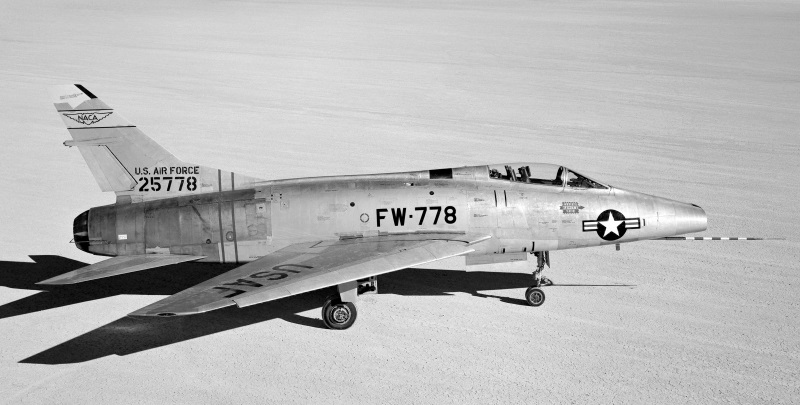
There were further changes in F-100A production. The 104th production aircraft introduced cockpit modifications, while the 168th introduced the P&W J57-P-39 engine, with 71.2 kN (7,255 kgp / 16,000 lbf) afterburning thrust. A total of 203 F-100As was built to April 1955, all at the Inglewood plant. While very clean in appearance, the F-100A was not well liked, having a high accident rate, particularly due to its "hot" landing characteristics. One pilot suggested that its best use was as a static display, and some authors have mocked the F-100 as the "Not So Super Sabre".
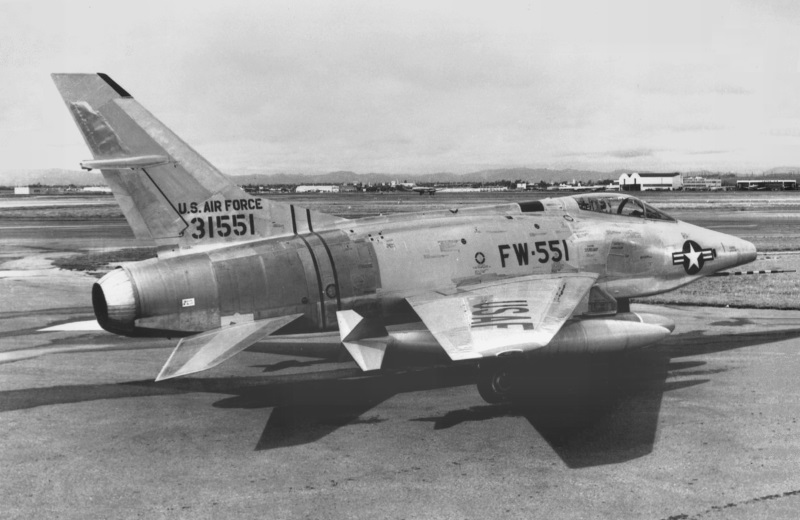
Six F-100As were modified as "RF-100A" reconnaissance machines, the cannon being removed and replaced with five cameras, the fuselage under the cockpit being distinctively bulged to accommodate the camera systems. These modifications were codenamed SLICK CHICK for some reason, and may have performed high-speed intrusions over Communist territory. Since they operated in full afterburner during airspace penetrations, they were generally fitted with four drop tanks instead of the usual two, the RF-100A having been given a new pylon inboard on each wing to handle the extra tanks. The Air Force adopted a reconnaissance version of the McDonnell F-101 Voodoo, the "RF-101", for the reconnaissance mission, and the SLICK CHICK conversions were not followed up.
BACK_TO_TOP* Although the F-100 had been designed as an air-superiority fighter, aircraft design was moving so fast at the time that it was soon outclassed in that role, with the F-100A being retired from first-line service with the USAF in 1958, lingering in Air National Guard (ANG) service to 1980.
The Air Force decided to use the F-100 for the fighter-bomber mission instead -- the primary focus at the outset being on tactical nuclear strike -- leading to the next version, the "F-100C". The prototype, a conversion of an F-100A, performed its first flight on 9 September 1955 with test pilot George Hoskins at the controls. The "F-100B" designation was originally applied to an improved derivative of the Super Sabre, which was never actually built as originally defined, and of which more is said below.

The F-100C featured:
The first production F-100C performed its initial flight on 17 January 1955 -- this machine retaining the troublesome short tailfin -- with test pilot Al White at the controls, leading to initial service deliveries in July 1955. On 20 August 1955, the first F-100C, piloted by Colonel Harold Hanes, set the world's first sustained Mach 1 speed record of 1,323.061 KPH (822.135 MPH).

This particular machine was eventually passed on to the US National Aeronautics & Space Administration (NASA) and had a long career as a test aircraft. NASA would fly a number of F-100s on tests and trials, incidentally, designating them "JF-100".
___________________________________________________________________
NORTH AMERICAN F-100C SUPER SABRE:
___________________________________________________________________
wingspan:
11.58 meters (38 feet)
wing area:
35.77 sq_meters (385 sq_feet)
length:
14.53 meters (47 feet)
height:
4.88 meters (16 feet)
empty weight:
9,525 kilograms (21,000 pounds)
max loaded weight:
12,700 kilograms (28,000 pounds)
max speed at altitude:
1,320 KPH (820 MPH / 715 KT)
service ceiling:
15,250 meters (50,000 feet)
range (no drop tanks):
920 kilometers (575 MI / 500 NMI)
___________________________________________________________________
Service deliveries of the F-100C began in April 1955. The Air Force was eager enough to get F-100Cs that a second production line was opened at the North American plant in Columbus, Ohio, in addition to the company's plant in Los Angeles. The first Columbus-built F-100C performed its initial flight on 8 September 1955. 451 F-100Cs were built at Inglewood, while 25 were built in Columbus, for a total of 476.
The F-100C equipped the USAF "Thunderbirds" flight demonstration team from 1956 through 1963, performing 641 displays. The F-100Cs were modified with smoke trail generators, which involved injecting diesel fuel into the exhaust; they also had cannon and other combat kit removed. Surprisingly, for a time the demonstrations included a sonic boom -- presumably by an aircraft flying at height, since at low altitude a sonic boom could blast out windows and cause considerable damage. Eventually, the US Federal Aviation Administration laid down the law, and banned sonic booms at airshows. For the 1964 season, the Thunderbirds then traded their F-100Cs in for Republic F-105 Thunderchiefs. However, the Thunderbirds had by no means seen the last of the F-100.
Since the Thunderbirds didn't generally fly overseas -- deployment across the oceans was troublesome -- the Air Force established a flight demonstration team in Europe named the "Skyblazers", with colors like those of the Thunderbirds. The Skyblazers originally flew F-80s and then F-86Fs, but flew F-100Cs from 1956 to 1961, when the team was disbanded.
* In 1956, production moved on to the definitive variant, the "F-100D". Changes included:
The F-100D was powered by the same J57-P-21 engine as the F-100C; given the increase in weight, the top speed of the F-100D was somewhat less than that of the F-100C. It also retained the inflight refueling probe, which was straight at the outset; the kinked probe wasn't introduced until well into F-100D production. Some number of F-100Ds were modified in service with a radio control system for the "Bullpup" air-to-surface missile -- though the Bullpup would prove inadequate, and it would never amount to much as a Super Sabre store.

940 F-100Ds were built at Los Angeles and 334 were built at Columbus, for a total of 1,274, the last being rolled out in late 1957. There were teething problems early on, with various fixes applied in a patchwork fashion, until it seemed no two F-100Ds could be judged exactly alike. From 1962, the F-100D fleet was brought up to a common standard under Project HIGH WIRE. Although the F-100A had not proven satisfactory, in maturity the F-100D was seen as a respectable, if not leading-edge, fighting machine.
The Thunderbirds flight demonstration team found that while the F-105 Thunderchief was a powerful and impressive machine, it was unsuited to the flight display role, being too big, and designed for high-speed low-level flight at the expense of agility; after a fatal accident, they went back to the Super Sabre, having flown the Thunderchief in only a half-dozen displays. The Thunderbirds obtained F-100Ds, flying a total of 471 displays from May 1965 to November 1968.

* The F-100 having proven a dangerous handful for inexperienced pilots from its introduction to service, a single F-100C was modified on the production line as a tandem two-seat conversion training aircraft, with a 91-centimeter (1-yard) fuselage extension to accommodate the second seat. Initial flight of this "TF-100C" was on 24 January 1956, with Robert White at the controls, and following successful test evaluation, the two-seater went into production as the "F-100F".
The first production F-100F performed its initial flight on 7 March 1957, piloted by George Mace. The TF-100C was originally designed for conversion and proficiency training, having no real combat kit, and featured the flapless F-100C wing; the F-100F was combat-capable, being as closely derived from the F-100D as possible, though it was only fitted with two cannon, the Air Force having decided to have it provide weapons training as well as flight training. It would also see combat action.
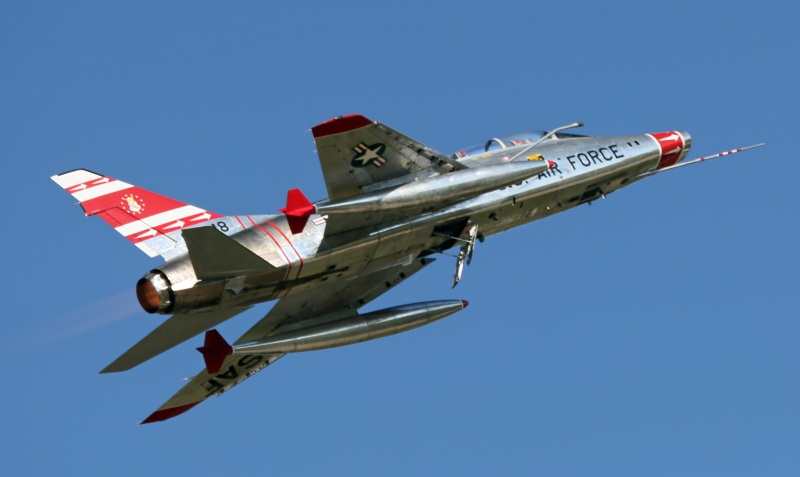
The F-100F featured a one-piece canopy, hinged to the rear, over both seats. The F-100F also retained the J57-P-21 engine; since it had even greater empty weight than the F-100D, performance fell off further. 339 F-100Fs were built in Inglewood to the end of Super Sabre production in October 1959. Late production F-100Fs had improved navigation avionics, including an AN/ASN-7 dead-reckoning computer, and a PC-212 Doppler radar; they also had modified flaps with a duct over the top that directed airflow over the top of the flap, increasing low-speed effectiveness.
A total of 2,294 Super Sabres was built in all. Production breakdown was as follows:
Three F-100Fs were later used in trials, one for a thrust reverser system, these aircraft being redesignated "NF-100F". There was a proposal to re-engine F-100Ds and F-100Fs with the British Rolls-Royce RB.168-25R afterburning bypass jet engine, which would have meant more warload, more range, and better performance -- but the "F-100S", as it was designated, never happened.
BACK_TO_TOP* The first "action", of sorts, seen by USAF Super Sabres was during the American intervention in Lebanon in the summer of 1958. This operation was in response to local unrest and Arab radicalism, the perceived source of the trouble being Egyptian President Gamal Abdel Nasser; US troops were sent in to show Nasser that America would be able to respond to provocations if necessary. The invasion was perfectly amiable, US Marines landing on the beaches at Beirut to be greeted by locals in swimsuits and vendors selling ice cream. F-100Ds flying out of Incirlik, Turkey, flew top cover, but didn't fire a shot.
The F-100D and F-100F saw plenty of action in Vietnam, however, through most of the conflict. They were "in-theater" from 1962, flying out of Takhli Air Base in Thailand, but didn't see combat until 1964. By that time, the war was heating up, and F-100Ds were deployed to Da Nang AFB in South Vietnam from Clark AFB in the Philippines to be ready for action. They got it on 9 June 1964, when eight of them performed retaliatory strikes on Communist anti-aircraft sites in Laos, after two Navy reconnaissance jets were shot down.
That mission remained secret -- but in the middle of December 1964, the US began to "go public" with a series of air strikes that were performed in retaliation for Communist provocations. With the FLAMING DART sequence of strikes in February 1965, the F-100Ds went over North Vietnam, hitting anti-aircraft sites on 8 February, with further missions over the next few weeks.
On 2 March, the first of the large-scale ROLLING THUNDER attacks were performed against North Vietnam, with 40 F-100Ds and F-100Fs participating. More F-100s were brought into the theater, but the Air Force quickly decided that Super Sabre was too slow to go North; its use of probe-&-drogue instead of boom refueling also complicated logistics for a strike package. The F-100s were used from March 1965 for battlefield support in South Vietnam (and peripheral theaters) instead.
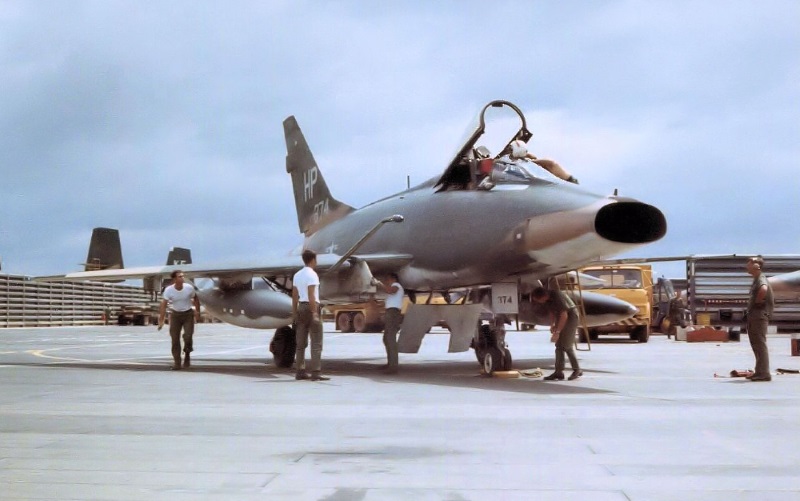
However, four F-100Fs were fitted out as "Wild Weasel I" defense suppression aircraft, and continued to go north to protect strike packages well into 1966. The Wild Weasel "EF-100Fs" were fitted with an avionics suite to detect, identify, and locate enemy air-defense sites, with the kit including:
The EF-100Fs initially directed F-105s to attack the sites. Three more EF-100F conversions were performed, with the Wild Weasel Sabres being equipped with the AGM-45 Shrike anti-radar missiles from 1966. The EF-100Fs weren't in business much longer, being replaced by the more potent EF-105F Wild Weasel III.
* In the meantime, the "Hun", as it was nicknamed, was becoming the mainstay strike aircraft for the "in country" war, with 198 in service by the beginning of 1967. In 1968, four US Air National Guard Super Sabre squadrons were deployed to Southeast Asia to add even more flying firepower. They flew out of local airfields, where they were parked behind steel revetments as a protection against enemy sapper and mortar attacks. Although the F-100's hydraulic systems were a nuisance to keep in working order, and there were some maintenance problems due to tropical environmental conditions at first, ground crews proved adept in keeping their machines flying, with the Super Sabre proving highly reliable in difficult operating conditions. It was also more agile and accurate in its attacks than larger machines, like the F-105 and F-4 Phantom.
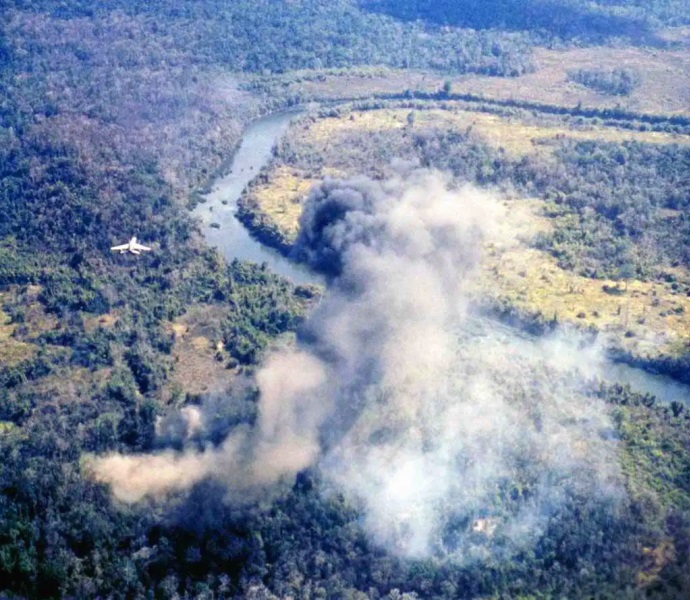
The F-100s performed strikes with 340-kilogram (750-pound) bombs, 70-millimeter (2.75-inch) rocket pods, napalm tanks, cluster munition dispensers, and cannon. A network of ground-based "Combat Skyspot" AN/MSQ-77 radar stations was set up over the theatre to permit strikes in all weather, day or night. The Combat Skyspot stations would track the strike aircraft, direct them to the target, and tell them when to release ordnance.
The Huns did an excellent job, notably dropping large quantities of ordnance in the defense of Khe Sanh in early 1968. F-100 pilots acquired a reputation for being able to put bombs precisely on target, despite the lack of anything that honestly looked like a bombsight, pressing their attacks in close to ensure accuracy. However, ground troops generally preferred the "slow movers" such as the piston-powered A-1 Skyraider to the "fast movers" like the F-100 for battlefield support. Although the fast movers could get on the scene faster and return more quickly after a reload, the slow movers could loiter over the battlefield for an extended period of time, dropping ordnance or hosing down targets with cannon fire as requested by the troops.
From 1967 to 1970, some of the F-100Fs were also used under the "Commando Sabre" effort as high-speed forward air control aircraft; or "fast FACs", callsign "Misty". The Misty FACs were flown in high-threat environments, where the "low-&-slow" spotters were too vulnerable. The pilots were volunteers; back-seaters were selected from experienced spotters, who were able to see through camouflage. The F-100Fs marked targets with smoke rockets.
Mistys were particularly active over the Ho Chi Minh trail, busting trucks. The North Vietnamese set up air defenses along the Trail, so the Mistys were under orders not to fly below 1,220 meters (4,000 feet), not fly straight and level, and not make a second pass over a target. Two USAF chiefs of staff, Ron Fogelman and Merrill McPeak, both flew Misty FAC flights, as did Dick Rutan, brother of well-known aircraft designer Burt Rutan, Dick having piloted the Voyager aircraft on a record-breaking round-the-world flight in 1986. Misty FAC attrition rate was high, with seven aircrew killed and four taken prisoner.
The F-100 was pulled out of the theatre in July 1971, after flying over 360,000 sorties. It had been an expensive exercise, with 186 Huns lost to anti-aircraft artillery, 7 to enemy ground action, and 45 to accidents. There were no losses to enemy fighters, and the Huns officially scored no kills; Captain Don Kilgus claimed a MiG-17 over North Vietnam on 4 April 1965, but was only credited with a "probable". The F-100 was phased out of TAC service in 1973, but was retained in Air National Guard squadrons until 1980. It was replaced in line USAF service by the Vought A-7D, which was a much more modern and effective tactical attack aircraft.
The F-100 kept on flying in US service, however, if in the inglorious role of target drone. From 1981, Sperry converted 325 F-100Ds and F-100Fs to a "QF-100" radio-controlled drone configuration; they were fitted with chaff-flare dispensers to act as more realistic targets; a self-destruct charge in case they "slipped the leash"; and propane heaters on the wingtips to attract Sidewinders -- allowing the drone to survive such attacks and be flown again. The QF-100s flew into the 1990s. Five F-100s then remained flying with a civilian contractor named Flight Systems INC as tow target tugs, under a military contract, these machines being finally retired in 2001. Apparently, a few Super Sabres were also employed as flight-test chase planes late in their lives.

* There were a number of foreign users of the F-100:
A number of F-100s survive as museum displays; a few are still flying on the warbird circuits at last notice.
BACK_TO_TOP* The F-100B, mentioned earlier, began life as the "NA-212", an all-weather fighter-bomber based on the F-100A. Design work began in June 1953, the design originally looking like an F-100A with an extended nose, but it underwent a number of zigs and zags -- first with a vee-style intake below the nose, then with a vee-style intake above and behind the cockpit. After a year of work, the USAF ordered nine machines for evaluation, though the order was later scaled back to three "F-107A" prototypes. Some sources identify the type as the "YF-107A", but all the prototypes were painted with the label "F-107A". It was, at least informally, known as the "Ultra Sabre".
The first F-107A performed its initial flight on 10 September 1956 from Edwards AFB, with Robert Baker at the controls. The F-107A had some resemblance to the original F-100A from the wings on back, though the wings had a thinner chord, and the tailfin was of "all-moving" configuration -- a scheme that North American would use on its A-5 Vigilante carrier-based attack aircraft.
The wings had automatic leading-edge slats; full-span flaps; and no ailerons, with spoilers used for roll control. The aircraft was fitted with an early fly-by-wire flight control system. The aircraft was to carry a semi-recessed nuclear munition recessed into the belly, to be delivered with a LABS system; an external tank could be carried in the same position, in place of the nuclear munition. Built-in armament consisted of four 20-millimeter cannon, though only one of the three prototypes had cannon armament.

Forward of the wings, the F-107A was entirely different from the F-100A, with a slender nose and the engine intake above and behind the cockpit, feeding a P&W J75-P-9 turbojet -- essentially a bigger and badder derivative of the J57, with 76.5 kN (7,800 kgp / 17,200 lbf) dry thrust and 109 kN (11,115 kgp / 24,500 lbf) afterburning thrust. Incidentally, the intake was moved from bottom to top because wind-tunnel tests showed it caused problems with the separation of a centerline nuclear store in the bottom position; no doubt, the upper position promised to reduce problems with foreign object ingestion as well. The first two prototypes had a two-position engine inlet duct, but the third prototype had an automatic, continuously variable duct.
___________________________________________________________________
NORTH AMERICAN F-107A:
___________________________________________________________________
wingspan:
11.15 meters (36 feet 7 inches)
wing area:
34.93 sq_meters (376 sq_feet)
length (no probe):
18.54 meters (60 feet 10 inches)
height:
5.94 meters (19 feet 6 inches)
empty weight:
12,700 kilograms (28,000 pounds)
max take-off weight:
18,145 kilograms (40,000 pounds)
max speed at altitude:
2,090 KPH (1,300 MPH / 1,130 KT)
service ceiling:
12,000 meters (46,000 feet)
range:
2,495 kilometers (1,550 MI / 1,345 NMI)
___________________________________________________________________
The F-107A was in competition with the Republic F-105 Thunderchief, and the Air Force chose the F-105. The three F-107As were used for flight test. Two of them were passed on to the US National Advisory Council for Aeronautics (NACA), the ancestor of NASA. The first F-107A ended up in the Pima Air Museum in Arizona; the second is now in the possession of the US Air Force Museum in Dayton, Ohio; and the third was lost in a mishap while in NACA service. The F-107A was the last fighter to be built at the Inglewood plant.

A model has also survived of another considered F-100 derivative -- an elegant dart of an aircraft with a needle nose and an engine intake on each side of the fuselage, below the cockpit. It was clearly speculative, since specifics were misplaced or lost, and there's nobody left around who remembers any details.
BACK_TO_TOP* During the Cold War, the vulnerability of airfields to attack was obvious to military planners, and a number of schemes were dreamt up to develop ways to fly aircraft without using airfields. Early experiments with vertical take-off and landing (VTOL) aircraft, the "flying pogos", focused on aircraft that could take off straight up and land on their tails. Taking off wasn't so troublesome, but landing was a frightening procedure, and the concept did not inspire enthusiasm.
Another approach was considered: slap a rocket booster onto a conventional aircraft, and simply blast it up into the sky. "Rocket-assisted take-off (RATO)" rockets had been used to help get heavily-loaded aircraft off the runway since the end of World War II, and developing a bigger rocket to do the whole job didn't seem like too big a stretch. Besides, by 1953, contemporary cruise missiles were being launched with precisely such a technology. The idea materialized in the form of a program named "Zero Length Launch / Mat Landing (ZELMAL)". Not only would a Republic F-84G Thunderjet fighter be blasted into the sky by a big booster rocket, it seems obtained from a cruise missile; the fighter would also land, gear up, on a huge inflatable mat, 25 x 245 x 1 meters (80 x 800 x 3 feet) in size, and snag an arresting cable to stop.
Tests were begun in 1953 at Edwards Air Force Base in California. The launches were easy, the mat landings were a fiasco -- hard on aircraft, hard on pilots, entirely impractical. ZELMAL was halted after a few dozen launches. Although the mat landings were a bad idea, the rocket take-offs had actually worked pretty well, and in 1957 the Air Force decided to revive that part of the concept. The idea was to launch a nuclear-armed strike aircraft from a truck trailer, bomb a target, then have the pilot bail out over friendly territory. The scheme became simple "zero length launch", abbreviated as "ZELL", truncated to "ZEL".
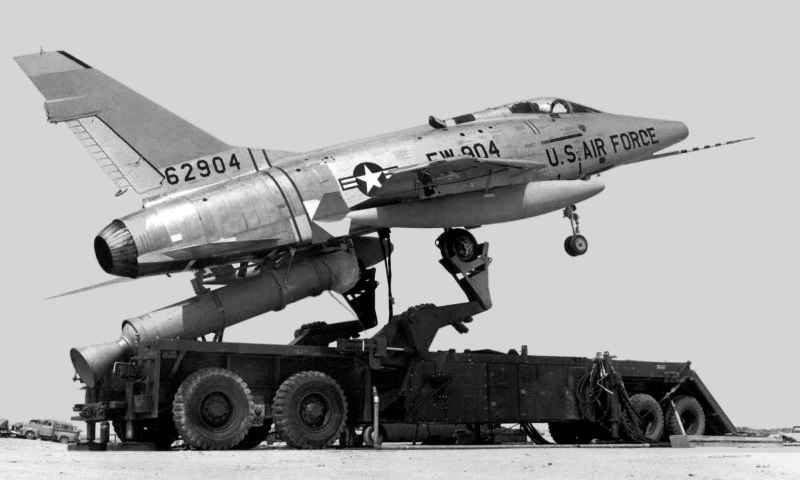
The Super Sabre was seen as best suited to the scheme, with two F-100Ds modified for booster launch. However, the F-100D weighed over twice as much as the F-84, and so required a really big booster rocket to get it into the air. The booster was built by Rocketdyne and generated almost 578 kN (59,000 kgp / 130,000 lbf) of thrust for four seconds, providing a maximum acceleration of 4 gees. The aircraft would be instantly airborne, flying at an altitude of 120 meters (400 feet) and almost 450 KPH (275 MPH) at rocket burnout.
Engineers conducted preliminary launch tests with an "iron bird", a structure of steel and concrete that simulated an F-100. The iron bird performed some really impressive maneuvers, such as backward somersaults, that demonstrated the importance of precisely aligning the booster.
The first actual shot with an F-100D went fine. The test pilot, Al Blackburn, found it "exhilarating" and "better than any ride you can find at Disneyland." The second launch didn't go so well. The booster didn't separate, and nothing Blackburn could do would shake it off; he had to eject and let the aircraft crash into the desert. A postmortem showed the booster had hung up on the attachment bolts, which were supposed to shear off, but didn't. The attachment scheme was modified with explosive charges that could blow the bolts off on command.
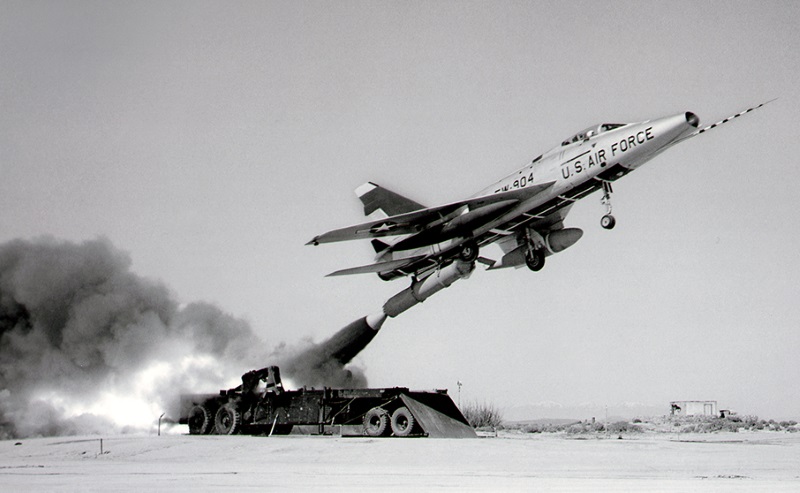
Fourteen more flights were performed between March and October 1958. All these shots went well, and flights became perfectly routine. Indeed, it seems that the general impression was that they were great fun; one pilot performed a ZEL launch for a public demonstration, and did a slow roll immediately after booster separation. There was no doubt of the technical feasibility of ZEL, but by that time there were doubts that hauling a nuclear-armed fighter around the countryside on a truck was really such a good idea after all. In consequence, a few launches were performed from inside a hardened shelter at Holloman AFB in New Mexico, with the very last launch on 26 August 1959. There were no problems.
The last F-100Ds built had attachment points for a ZEL booster rocket. In 1963, the German Luftwaffe sponsored similar launch experiments with a single F-104G strike fighter. Nothing came of any of it; nobody wanted to field ZEL. The idea was sexy, it worked well on a strictly technical basis -- but it was expensive, while it presented thorny logistical and security concerns. In the end, the capability offered by the system was provided by battlefield missiles and the Harrier VTOL "jump-jet" that didn't need a booster rocket.
BACK_TO_TOP* I still have a memory of the F-100 from when I was stationed down at Fort Hood, Texas, as an Army signal operator in 1973:1974. I was sitting up on a hill during a field exercise and watching "Huns" make simulated strikes on an artillery battery I was providing communications support for. A Chaparral (Sidewinder) tracked SAM launcher was near my communications truck and was tracking the intruders. I believe I also saw the Thunderbirds flying F-100s when I was a lad in the early 1960s, but I long ago lost any clear memory of it.
I do remember how widely the zero-length launch scheme was known at that time. Model kits were available not only for the F-100 ZEL concept, but for the F-84 and F-104 implementations as well. I even recall an episode of the 1960s MAN FROM UNCLE TV spy series in which a gang of terrorists attempted to seize a nuclear-armed ZEL fighter hidden in an underground silo. Interestingly, the head terrorist was Slim Pickens, immortalized for his role as B-52 commander Major "King" Kong in Stanley Kubrick's movie DR. STRANGELOVE -- riding an H-Bomb to glory in one of cinema's most famous images.
Sometimes it's interesting to find out what really happened to those wild ideas dreamed up decades ago that had their moment of fame but amounted to little. ZEL still pops up on occasion in things like anime videos; there's just something sexy about it.
* I was once given an Armour Collection diecast F-100 as a gift. After receiving it, I looked it over and suddenly realized the model had US Navy markings! I wasn't at all sure it was a mistake, either; I had a suspicion that the Navy, which adopted "dissimilar aircraft" fighter school air-combat training before the Air Force, might have obtained hand-me-down F-100s because the Super Sabre was comparable to the Soviet Mikoyan MiG-19 in performance and, to a degree, in configuration. However, I have been unable to find any references that confirm this notion.
* Sources include:
* Illustrations details:
v1.0.0 / 01 may 15 v1.0.1 / 01 apr 17 / Review & polish. v1.0.2 / 01 mar 19 / Review & polish. v1.0.3 / 01 jul 19 / Format modernization. v1.0.4 / 01 may 21 / Added images. v1.0.5 / 01 apr 23 / Review & polish.The ZEL section was derived from a document I put together in 1996 and revised to 2015, when I decided to break it up and incorporate it into this and other documents.
